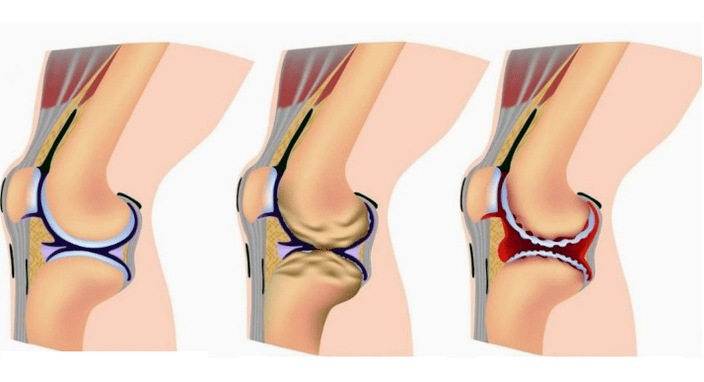Osteoarthritis and arthritis both affect the joints and have similar symptoms. Therefore, they are often confused. Although their names are consonant, however, they are completely different diseases. If arthrosis destroys the joints, then arthritis causes an inflammatory process throughout the body. This is the basic difference between osteoarthritis and arthritis. Now in more detail.
The most important thing about arthritis
Arthritis is a progressive disease triggered by infection, immune system or metabolic disorders, hormonal disorders. There are over 200 types. The main symptoms of arthritis are inflammation in the joint area, swelling, redness of the skin. In advanced form, this disease gives complications to the heart, kidneys and liver. At risk are those aged 25 to 40 years.

Symptoms of arthritis
The disease may be hidden. The first signs of arthritis are usually:
- illIt comes on suddenly and gets worse with movement. It is more strongly felt at night, after sleep, stiffness is felt;
- Tissue changes. Arthritis is characterized by swelling and redness of the skin, synovitis and bursitis are possible (in the first case, this is inflammation of the synovial membrane, in the second, the articular bag);
- Temperature rise. As a rule, the temperature rises in the affected joint. A high body temperature (38-39 degrees) can also be observed.
Symptoms worsen the manifestation of the inflammatory process:
- prostrating;
- painful urination;
- shivering;
- conjunctivitis.
If the symptoms are ignored, the disease will become chronic. As a result, the work of internal organs will be disturbed, and joint modification can cause disability.
The most important thing about arthritis
Osteoarthritis is a non-inflammatory disease that leads to deformation and destruction of cartilage tissue. Cartilage covers the surface of the joint and prevents the bones from touching each other. When it is in order, the person moves freely and without pain. Pathological causes can be different: heredity, deviations in the joint structure, injury, excessive load. Unlike arthritis, this disease only affects the joints.
Osteoarthritis usually develops in older people, as the articular surface wears down with age. This disease is also found in people who, by work, burden the joints of the hands, wrists, and feet. Therefore, arthrosis is also called "athlete's disease" or "pianist's disease. "
Symptoms of arthritis
This disease is lazy. In the early stages, symptoms may not appear. The first symptoms of osteoarthritis are usually as follows:
- Joints do not move after sleep or long rest, but this quickly disappears with movement;
- Crunches, clangs, clicks - all this is accompanied by a dull sound;
- Pain on movement and energy.
In the final stage of arthrosis, the symptoms are already noticeable: the joint becomes more immobile, pain appears, and the "hard joint" syndrome also develops - soft cartilage tissue is replaced by bone growth. The development of this disease leads to immobilization of one or more joints.
Special signs of arthritis and arthrosis

By carefully studying the symptoms and causes of arthrosis and arthritis, you can easily see the difference. We have combined the disease differences to make these differences clearer.
special features |
arthrosis |
Joint pain |
affected area |
Joints, cartilage, spaces between bones |
Joints, bones, internal organs: heart, liver, kidneys |
The nature of the disease |
Deteriorating, ruining. Only joints are affected |
Inflamed. This disease affects internal organs |
Common Causes |
Increased pressure on the joints, descent |
Severe infection, metabolic disorders |
Age |
It develops in people of mature or advanced age. Risk factors - activities related to excessive pressure on the joints |
It develops in people from 25-40 years, but also occurs in teenagers and children |
ill |
Often this is a mild pain that appears during movement and power loads. In the next stage, the pain becomes more intense. |
The pain worsens with movement, most acutely felt in the early morning. |
Crunchy and angry |
Deaf knocking, dry hoarseness or grunts are characteristic |
Does not belong to the characteristics |
Change the shape |
The joint is deformed, the inflammatory process is indicated |
There are seals, swelling, redness and fever in the joint area. Deformation occurs if one disease has developed into another disease. |
Reduced mobility |
Arthrosis only binds the affected joints. |
Stiffness throughout the body or in the joints |
Acute symptoms |
The joint "hardens" due to the formation of bone growth. In this case, the person can no longer move their legs or fingers. |
High temperature - 38-39 degrees, conjunctivitis develops, there is damage and fever |
Development of symptoms |
It develops slowly, in the early stages it is asymptomatic |
In the early stages, there are symptoms of inflammation in the affected joint area. |
Prevention of arthritis and arthrosis
This disease is easier to prevent than to treat. Disease prevention includes:
- Moderate physical activity - fitness, swimming pool, skiing, cycling is suitable;
- Joint gymnastics - you can do it with a trainer in exercise therapy or stretch your joints at home;
- Proper nutrition - if there is a tendency to bone disease, it is worth avoiding red meat and high-fat foods. It is better to add more fruits and vegetables, fish and seafood to the diet. If you are overweight, you should follow a diet;
- Drink enough water - 2 liters a day. It is advisable to avoid alcohol.
To reduce the risk of disease, doctors recommend wearing comfortable shoes, not sitting cross-legged, not getting cold, and not succumbing to stress.
If you experience symptoms that resemble arthritis or arthrosis, make an appointment at our Orthopedic Center. This disease significantly reduces the quality of life, so it is important to diagnose it in time and start treatment.















































